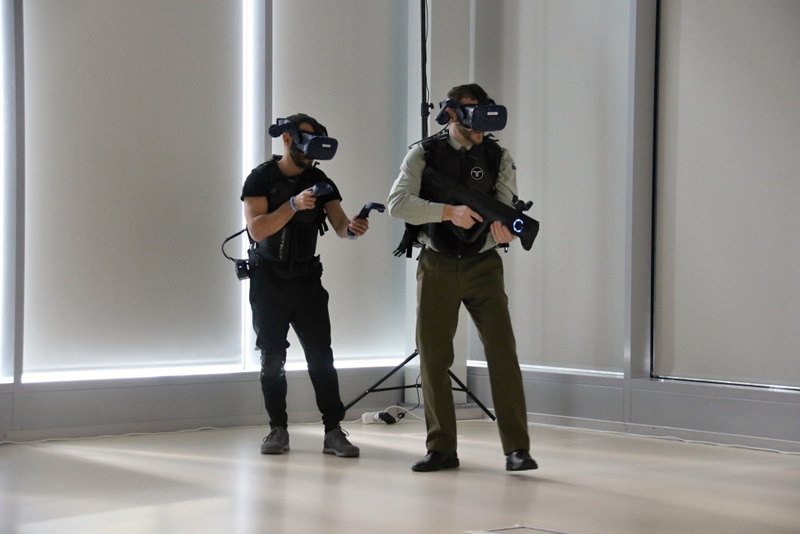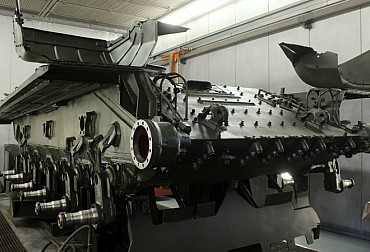Our soldiers could use the same Virtual Reality systems as US Army and Israel Defence Forces
Putting on special headsets that will create an illusion of a building with enemies and gripping a full size model of a firearm that can also simulate a recoil - those aids and technologies could be tried by participants of a specialized conference that recently took place in Prague and that was focused on simulation technologies in virtual reality. The use of Israeli technology that is used by IDF and US Army was part of the conference that was together held by Defence Industrial Cooperation Department of the Ministry of Defence and by Czech Institute of Informatics, Robotics and Cybernetics CTU. The conference showed to its participants future possibilities of active approach to education and training with use of virtual reality and also with demonstration of systems used for training by Israel Defence Forces that are leaders in the field.

Picture: The hall that became a battlefield with different surroundings for the participants | army.cz
At the beginning, it is necessary to state that the Czech Republic is also one of the leaders in the field of artificial intelligence and virtual reality. Czech Institute of Informatics, Robotics and Cybernetics CTU in Prague is very active in the field and the cooperation with the Ministry of Defence in exchanging information, experience, skills and interoperability is beneficial for both parts. Except for CTU there is also Centre of Simulation and Training Technologies in Brno where lieutenant colonel Přemysl Tuček is in charge. His team creates mainly a virtual reality environment; however, the army has had several years of experience with simulators.

Picture: The system was simplified for the purpose of conference, full size models of firearms that can simulate a recoil are used | army.cz
The history of live simulation in Czech Armed Forces goes back to 2002 when the first system MILES was supplied by an American company Lockheed Martin. The tactical simulator MILES was supplied for Sa. 58, UK. 59 and for RPG-7 and KONKURZ automatic firearms and for T-72 vehicle, IFV-1, IFV-2 and BRDM vehicle. MILES was supplied without a communication system and a possibility of ad-hoc upgrade. The system has never been updated and it is step by step being replaced by new simulator systems that meet present technology trends. Reconfigurable shooting and tactical simulator SSTBV/M was supplied by the company VILIS M.I.C. in 2006. It is equipped with a communication system and is suitable for IFV-2 and T-72 M4CZ vehicles. 3 pieces of simulator were supplied together with a set of target detectors that enable a training of shooting preparation thanks to a function of ballistic curve simulation without use of live ammunition. The expression “reconfigurable” means the 2in1 function which features the possibility to use one simulator for two different types of combat weapons thanks to an exchange of several wire connections and a software change. As far as other simulators are concerned, a system for Pandur and tens of firearms adapters for shooting preparation followed.

Picture: Putting virtual reality into practice | army.cz
Moshe Markovitz from the Israeli company Magnifica presented new methods and technologies at the conference. The simulations considerably speed up mental preparation for dealing with crisis situations which applies to armed forces and also to fire brigade and other parts of Integrated Rescue System, schools and hospitals. The possibilities of simulations are practically unlimited. As far the Ministry of Defence is concerned, the highly sophisticated training programme for shooters or projects concerning training of service dogs can serve as examples. Both above mentioned systems significantly speed up the training and are completely realistic; for example, the firearms simulate a recoil when shooting.

Picture: The operator can clearly see where the trainee is | army.cz
Moshe Markovitz also spoke about possible shortening of compulsory military service in Israel should the system be applied to a greater extent. Only time can tell how it is going to be like in the Czech Republic. The key factors will be finances and willingness to change some established orders and to adapt to progress.

Picture: Everyone who tried the technology spoke highly of it | army.cz
The presented technologies are unique mainly in the approach to teaching, education and training. It is not only about the use of technologies that enable training in areas that cannot be trained in a classic way, being it because of safety or high costs. It is about a complete change of teaching where an interactive approach instead of “inactive sitting in class” is applied which significantly speeds up the learning process and the participants achieve better results. It could also be a way to attract new army applicants.





















